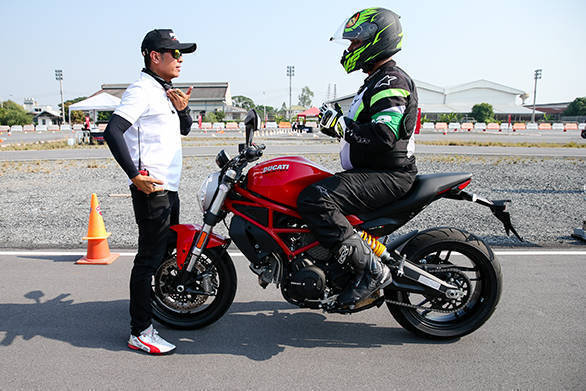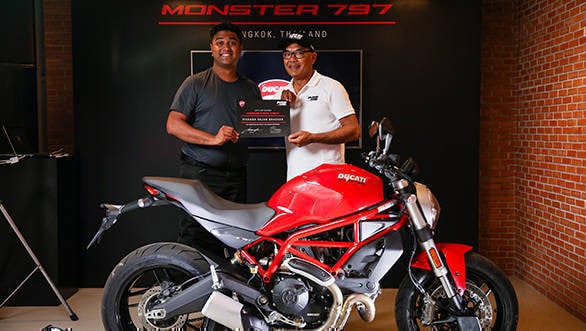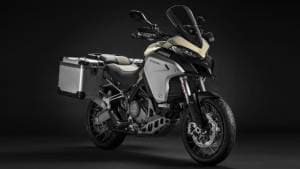Ducati Riding Experience: Lessons for those learning to ride for the first time
The Ducati Riding Experience is a school unlike any other that we've experienced, so far. Ducati has placed emphasis on improving riding skills, and in our books, riding schools serve as the best bet if one wants to learn to ride better. Ducati has been running the Ducati Riding Experience or DRE for over a decade, with an aim to maintain better control over the bike.
The Ducati Riding Experience comprises of three levels- DRE Safety, DRE Racetrack and DRE Enduro. The first programme concentrates on imparting basic riding knowledge as well as learning how to ride safely. This course is conducted, usually in an open lot with designated area to practice different drills. The DRE racetrack, as the name suggests, is for those who'd like to enhance their skills on a racetrack. There are four sub-levels, ranging from first timers to advanced who are looking to improve their lap times. The DRE Enduro, is all about learning to ride off-road. Lead by Beppe Gualini, the course teaches riders the basics of riding a motorcycle off-road, and students learn the skills on the Ducati Multistrada 1200 Enduro.

We've attended two DRE schools so far. Shumi has attended the DRE Racetrack session during the Ducati 959 Panigale first ride in Buriram, Thailand while I had attended the DRE Safety course during the Ducati Monster 797 Press Test in Bangkok, Thailand.
The course in Bangkok, during the Monster 797 ride, was designed to teach first time riders the basics of riding a motorcycle. You didn't need any prior experience of riding a motorcycle, and there were a few riders who'd never even sat on a motorcycle before. By now you may think that Ducati may be nuts as they were letting newbies ride a Monster 797. But as you'll read in the first ride report as well as our comprehensive first ride story, the Monster 797 is a fast yet friendly motorcycle to ride. And it's nimble handling made it quite easy to understand what was happening.

The beginner's course was also a great way of understanding the very basics of riding a motorcycle, and there were quite a few learnings that I picked up, despite having ridden motorcycles for a few years.
1. Starting off
The first drill was to understand how to get the bike off the parking stand without feeling intimidated about its weight. The ideal way to do so is to place both hands on the handlebar and use the hip to push the bike upright.
We were then explained the importance of understanding balance and how easy it is to push the bike once you've understood it. The instructors taught us to stand next to the bike, hold the handlebars and push it upright until the point where we didn't feel the weight of the bike was causing it to tilt on either side. Think of it as an equilibrium point, where the bike was completely upright. At this point, it's quite easy to hold on to the bike, even by the fuel filler cap on the tank.

Once we understood how to balance a bike, while standing next to it, we were asked to push the bike forward and backwards as well as walk around the bike, while holding it upright. The idea was to simulate a situation where one had to get a bike out of a crowded parking lot. At first it felt odd, but later on it was quite easy.
The next lesson in the drill was to learn to get on a bike. Many a times, we get on a bike incorrectly and in the process knock off an indicator stalk of in some cases, even drop the bike. The correct way to get on a motorcycle is to stand on the left of the bike, use the right hand to squeeze the front brake, look behind to check for clearance and then swing your right leg over.
2. Body position
This is one of the most crucial aspects of riding and it's the difference that helps people ride well or extract the best from their bikes. The ideal way to sit on a motorcycle is to use the lower half of your body to hold the bike, while the upper body stays loose and flows with the bike.
 Lek teaches me the importance of maintaining balance in a motorcycle
Lek teaches me the importance of maintaining balance in a motorcycle
We were repeatedly told to use our feet and thighs to lock into the bike and keep your upper body slightly crouched. A stiff body impedes control over the motorcycle and affects the ability to steer a motorcycle.
3. Releasing the clutch
The next step was to switch on the bike in neutral and then select first gear. Then begins the difficult part, learning when to let go of the clutch. If done wrong, the bike could either stall or worse, wheelie in case the rider has rolled on the throttle a bit too much. The DRE instructors taught us the importance of releasing the clutch slowly and understanding the bite point of the clutch.

On bikes such as the Monster 797, there is no need to roll on the throttle to get the bike going. Simply releasing the clutch slowly will see the bike moving ahead, there's that much torque down the rev range. We did a few runs where we'd simply let go of the clutch, let the bike roll some distance before pulling the clutch lever in and stopping.
4. Braking
Just as we'd learned to accelerate, we were asked to brake in a smooth and controlled manner. We had to accelerate up to a point after which we had to brake, within a designated spot that was marked with cones. There is a reason why we say that one needs to apply the brake and not grab the lever.

The exercise taught us the importance of progressive braking and its effect on ensuring that the bike comes to a smooth and stable stop
5. Vision
Where you look plays an important role in improving the riding experience. We were instructed to keep our head up as we kept practicing the acceleration and braking drills as well as the figure of eight drill that was designed to teach this specific aspect.

The further I looked ahead, the easier it was for me to positon myself for the next turn. Looking ahead also had a positive bearing on my throttle inputs and with each attempt, I could ride faster and lean harder into the corner.
6. Slalom time!
The instructors then prepared a slalom course which focused again on vision and throttle control. It also highlighted the importance of body position. We noticed that relative to our position, it was easier to complete the slalom by looking at the next cone instead of the immediate cone. That's how much of an effect looking far ahead has. Keeping the upper body loose also helped in flicking the bike from one side to the other and by the end of it, the slalom course was a breeze
7. Putting it all together
By the end of the day, we were let loose on a tight and technical track, as the instructors watched us ride and apply the lessons that we were taught. The circuit had a mix of long corners, a hairpin, short straight as well as a tight chicane. As I kept lapping the circuit, everything that was taught seemed to make sense. My body positon was helping me in the chicane, while keeping my head up and looking ahead made it easy to spot the exit at the end of a long corner.

 A happy bunch at the end of the DRE session
A happy bunch at the end of the DRE session
In the end, I was smoother on the motorcycle and that, to me, is the biggest take away from the Ducati Riding Experience.













